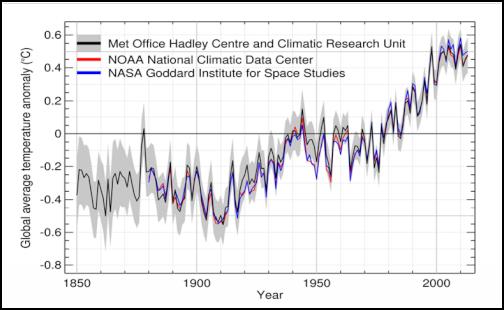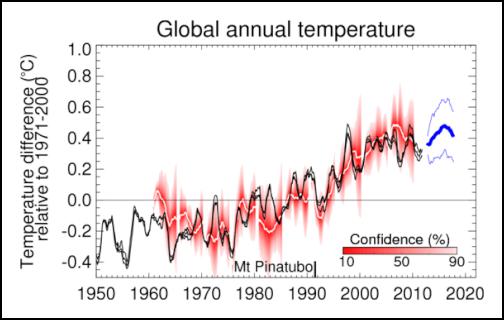2013 second warmest year on record for New Zealand region
MEDIA RELEASE MONDAY 6 JANUARY 2014
2013 second warmest year on record for New Zealand region
Data collected from New Zealand climate stations and analyzed by author of Living in a Warmer World, climate scientist Dr Jim Salinger show that 2013 was the 2nd warmest year on record for the New Zealand region.
• Winter 2013 was
the warmest on record nationally;
• Overall, 2013 was
the New Zealand region’s 2nd warmest year on record:
annual regional New Zealand mean temperature was
+0.84 °C above average, following 1998 at +0.89 °C above
average;
• Record annual mean temperatures were
recorded in the south east of the South Island;
• This
follows on from the Australian Bureau of Meteorology’s annual statement that shows 2013 was
Australia's warmest year on record;
• Above average
annual mean temperatures are anticipated to continue in the
New Zealand region for
2014.
Overview
2013 was the New
Zealand region’s second warmest year since reliable
records commenced in 1870. Mean temperatures across the New
Zealand region have been well above average in the months of
March, July, August and November.
The New Zealand regional mean temperature for 2013, derived from 22 land stations, and the 3 offshore islands, was +0.84 °C above the 1961–1990 long term average of 12.17 °C.
Record mean annual temperatures occurred in Masterton, Omarama, Timaru, Invercargill and the Chatham Islands. Winter 2013 mean temperatures were +1.27 °C above the 1961–1990 average, the highest on record. The New Zealand region has experienced just two cooler-than-average years (2004, 2009) in the last decade. The 10-year mean temperature for 2004–2013 was 0.26 °C above average, the highest on record.
This follows The Bureau of Meteorology’s announcement that the Australian area-averaged mean temperature for 2013 was +1.20 °C above the 1961–1990, the highest since records began in 1910. (see link http://www.bom.gov.au/climate/current/annual/aus/2013/)

Click for big version.
Source: World Meteorological Organization

Click for big version.
Source: Dr Jim Salinger
The World Meteorological Organization (WMO) produces an estimated global mean temperature by drawing on data from three global climate datasets maintained in the United Kingdom and USA. Preliminary data for January–November indicates that the estimated global mean temperature for 2013 is 0.49 °C above the long-term (1961–1990) average of 14.0 °C. 2013 ranks as the sixth-warmest year since global records commenced in 1880. No year since 1985 has recorded a below-average global mean temperature and nine of the ten warmest years have occurred in the past 12 years (2002–2013).
Major
climate influences during 2013
The El
Niño–Southern Oscillation (ENSO) was neutral; i.e neither
El Niño nor La Niña influencing New Zealand temperatures
during 2013. The Interdecadal Pacific Oscillation (IPO) was
negative, which favours more easterlies and north easterlies
at times with above average temperatures. At the same time
sea surface temperatures were above average by around 1 deg
C , especially surrounding the South Island and to the east.
2014 outlook
New Zealand regional
temperatures have warmed by 0.5 °C since 1950 and over 1
°C overall. This is similar to what has occurred globally,
and the general trend is expected to continue.
The Intergovernmental Panel on Climate Change (IPCC) Fifth Assessment report released in spring 2013 notes that recent trends have been largely controlled by increasing greenhouse gases augmenting the greenhouse effect. This influence is expected to continue, modulated by local influences.
ENSO neutral conditions are expected to persist at least until winter 2014, and negative IPO conditions are very likely to persist for the remainder of 2014. These conditions are presaged to bring above average temperatures of +0.2 to +0.6 °C above average for the New Zealand region.
The UK Met Office (below) is predicting global average temperature is expected to remain between 0.28 °C and 0.59 °C (90% confidence range) above the long-term (1971-2000) average during the period 2013-2017, with values most likely to be about 0.43 °C higher than average.

Click for big version.
Observed (black, from Hadley Centre, GISS and NCDC) and predicted global average annual surface temperature difference relative to 1971-2000. Retrospective predictions starting from June 1960, 1965, ..., 2005 are shown as white curves, with red shading representing their probable range, such that the observations are expected to lie within the shading 90% of the time. The most recent forecast (thick blue curve with thin blue curves showing range) starts from November 2012. All data are rolling annual mean values. The gap between the black and blue curves arises because the last observed value represents the period November 2011 to October 2012 whereas the first forecast period is November 2012 to October 2013. Source UK Met Office.
ENDS


 Consumer NZ: Despite Low Confidence In Government Efforts, People Want Urgent Action To Lower Grocery Bills
Consumer NZ: Despite Low Confidence In Government Efforts, People Want Urgent Action To Lower Grocery Bills NZ Banking Association: Banks Step Up Customer Scam Protections And Compensation
NZ Banking Association: Banks Step Up Customer Scam Protections And Compensation The Reserve Bank of New Zealand: CoFR Seeking Feedback On Access To Basic Transaction Accounts
The Reserve Bank of New Zealand: CoFR Seeking Feedback On Access To Basic Transaction Accounts 2Degrees: Stop The Pings - Half Of Kiwis Overwhelmed By Notifications
2Degrees: Stop The Pings - Half Of Kiwis Overwhelmed By Notifications Electricity Networks Association: How Many More Trees Need To Fall On Power Lines Before The Rules Change?
Electricity Networks Association: How Many More Trees Need To Fall On Power Lines Before The Rules Change? Parrot Analytics: Netflix Earnings - Price Hikes With Minimal Churn | Will Netflix Be A Bright Spot For Markets?
Parrot Analytics: Netflix Earnings - Price Hikes With Minimal Churn | Will Netflix Be A Bright Spot For Markets?



